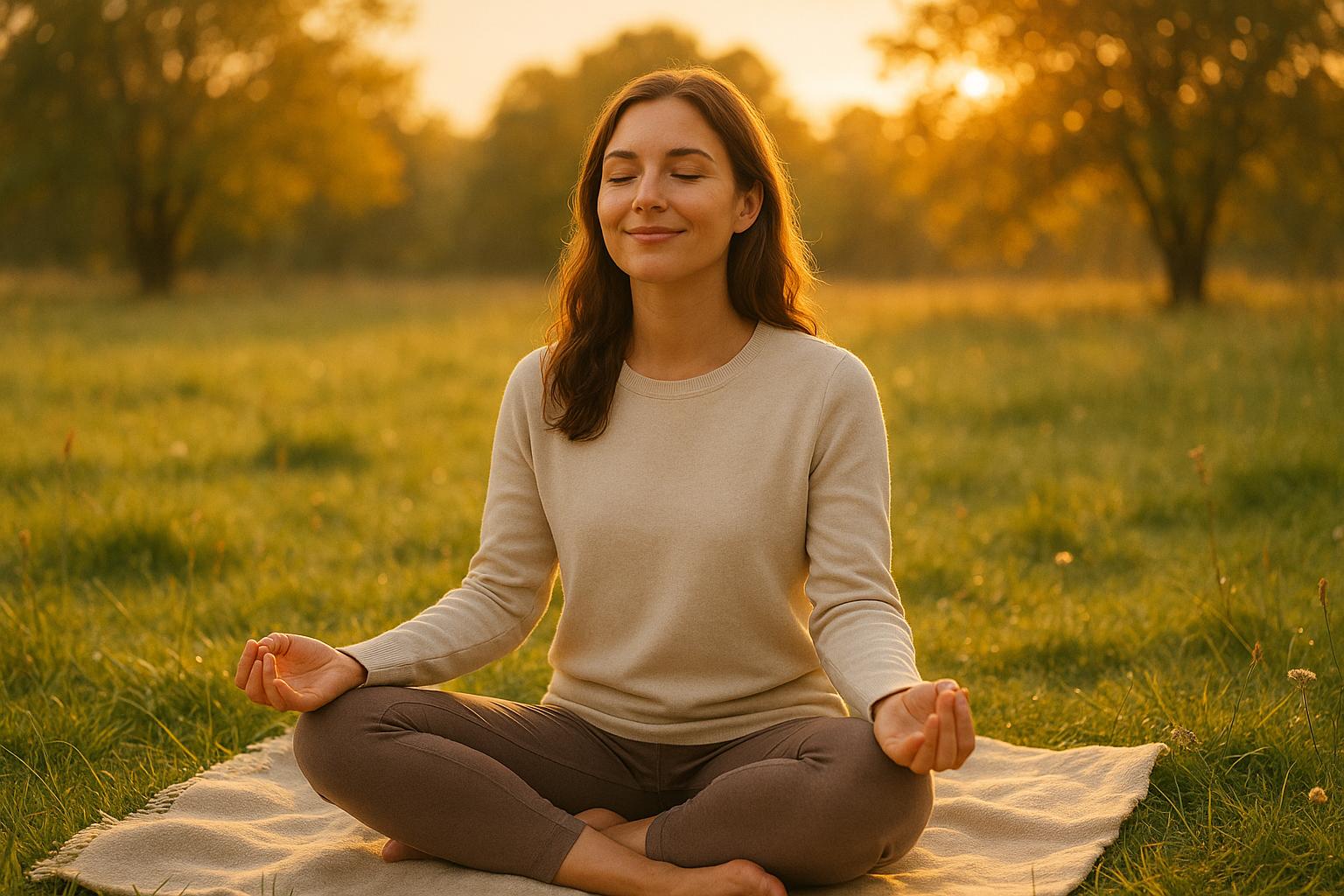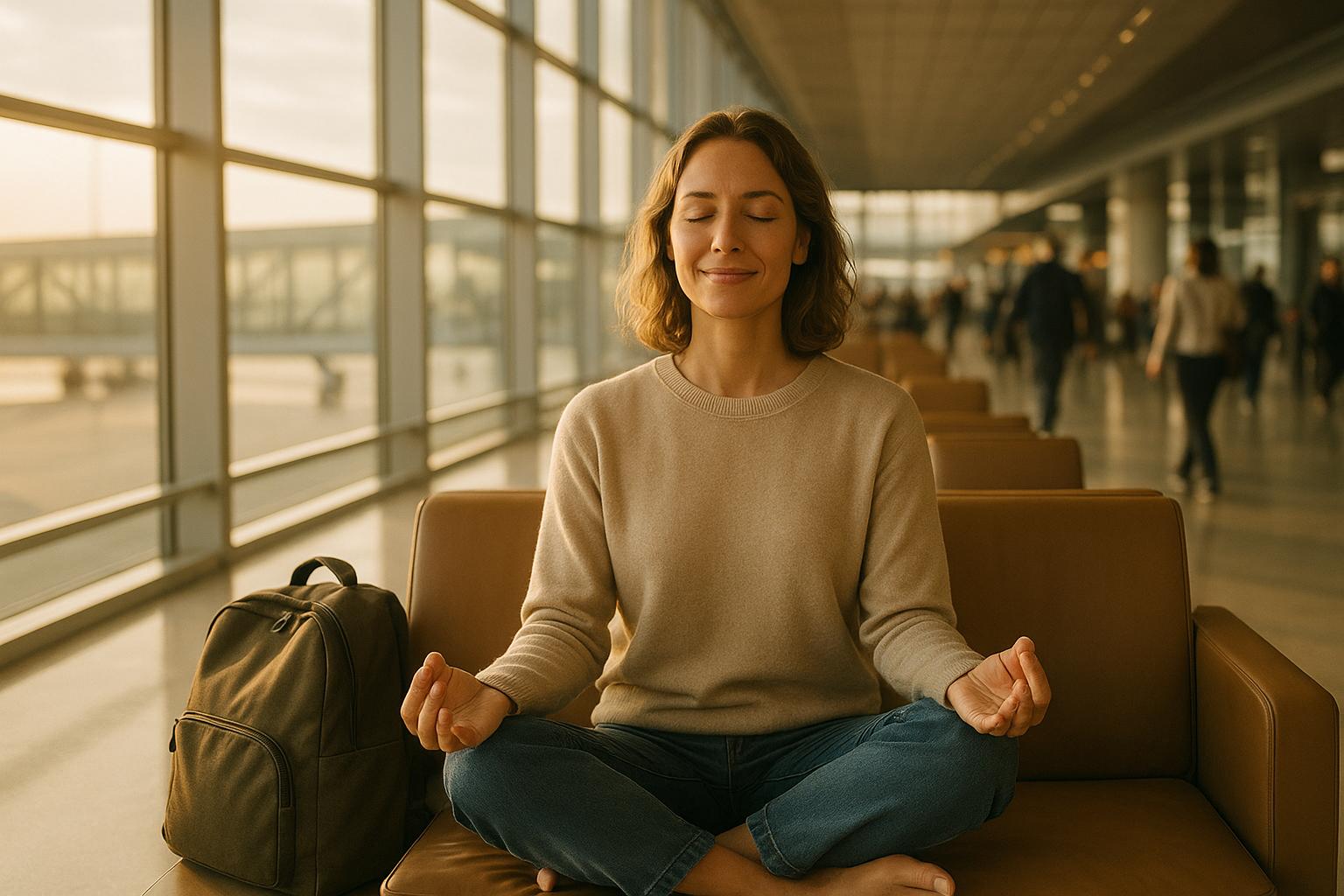Gratitude meditation shifts your focus from worries to positive aspects of life, helping reduce anxiety by stimulating serotonin and dopamine - chemicals linked to happiness and calm. Unlike other mindfulness techniques, it emphasizes reflecting on what you're thankful for, even during challenges, promoting emotional balance. Here's why it works:
- Reduces Anxiety: Studies show gratitude practices lower anxiety symptoms by 7.76%.
- Improves Mood: Boosts happiness, lowers stress, and enhances resilience.
- Simple to Practice: Can be done anywhere, requiring just a few minutes daily.
Other methods like breath awareness and body scan meditations also help manage anxiety but focus differently - on breathing rhythms or physical sensations. Each technique offers unique benefits, making it easier to find a practice that suits your needs.
1. Gratitude Meditation
How Well It Reduces Anxiety
Gratitude meditation takes a unique approach to easing anxiety by redirecting your focus from worries to the positive aspects of your life. Instead of dwelling on what’s troubling you, this practice trains your mind to notice and appreciate the good, which naturally quiets anxious thoughts.
Research backs this up: practicing gratitude releases serotonin and dopamine - chemicals in your brain that are tied to happiness and a sense of calm. These mood-boosters help shift your mental state toward contentment.
One meta-analysis involving 579 participants revealed that gratitude interventions led to a 7.76% reduction in GAD-7 scores compared to control groups. By consistently practicing gratitude, you can start to see challenges as opportunities rather than threats, fostering a more positive mindset.
Mental Health Benefits
The benefits of gratitude meditation go far beyond reducing anxiety. Regular practice has been linked to better mood, improved sleep, higher self-esteem, and stronger relationships. And the best part? Some people report feeling these effects after just five minutes a day.
"Shifting your attention to often-overlooked positives creates space for uplifting emotions, helping you feel balanced and less overwhelmed by anxiety even in tough times." - Calm Editorial Team
Gratitude also serves as a buffer against life’s challenges. Studies show that higher levels of gratitude can reduce the emotional toll of negative events and are associated with lower rates of suicidal thoughts. In one study, practicing gratitude meditation just four times a week for three weeks led to noticeable reductions in stress and depression, while boosting overall happiness.
Ease of Use and Practice
One of the greatest advantages of gratitude meditation is how simple and flexible it is. You don’t need a special setup or a lot of time - it can fit into your daily routine effortlessly. Whether you’re waiting for your coffee to brew, commuting, or winding down before bed, you can practice gratitude meditation anywhere.
The process itself is straightforward: sit comfortably, take a few deep breaths, and focus your thoughts on someone or something you’re grateful for. Even just a few minutes a day can make a difference.
For beginners, consistency is more important than time spent. Starting with five minutes daily - whether in the morning to set a positive tone or at night to relax - can yield noticeable improvements in mood and anxiety. Experts agree that this simplicity is part of what makes gratitude meditation so effective.
Lindsay Damoose, a Licensed Marriage and Family Therapist at Sharp HealthCare, highlights this accessibility:
"Gratitude keeps us grounded and is a way of practicing mindfulness. Gratitude allows us to be present and helps us refocus on what really matters in life."
Gratitude meditation’s adaptability makes it especially appealing for busy schedules. You can pair it with other mindfulness practices, like breathing exercises or body scans, to enhance your routine. Many also find that keeping a gratitude journal alongside their meditation helps maintain a positive outlook throughout the day, reinforcing the practice’s benefits.
2. Breath Awareness Meditation
How Well It Reduces Anxiety
Breath awareness meditation is all about focusing on your breathing. Unlike gratitude meditation, which encourages reflecting on positive experiences, this practice directs your attention to the natural rhythm of your breath. By doing so, it helps break the cycle of anxious thoughts and brings you back to the present moment.
This technique taps into your body’s natural relaxation response. When you focus on your breath, it helps balance your nervous system, calming both your body and mind.
"Whatever technique it is, just the fact that we are paying attention to our breath bridges the gap from the sympathetic and parasympathetic nervous systems." - Jessie Taylor, cofounder and director of education at the Mindfulness Center
Studies reveal that practicing mindful breathing for just four weeks can significantly reduce anxiety and stress levels. While gratitude meditation works by boosting feel-good chemicals like serotonin and dopamine, breath awareness meditation directly tackles stress and negative emotions through focused attention. These breathing exercises not only provide immediate relief from anxiety but also lead to long-term mental health benefits.
Mental Health Benefits
The benefits of breath awareness meditation go beyond easing anxiety. Regular practice has been associated with better cognitive function, improved stress management, and enhanced focus. While gratitude meditation tends to amplify positive emotions and improve sleep, breath awareness meditation sharpens your mental clarity and helps you regulate emotions more effectively.
"Breathwork meditation may deepen relaxation, improve your mood, and soothe physical illness." - Sian Ferguson
Another key benefit is the ability to stay present during tough moments. Over time, this practice strengthens your capacity to observe your thoughts without becoming overwhelmed by them - a skill that only grows with consistent effort.
Ease of Use and Practice
Breath awareness meditation is one of the simplest forms of meditation, making it accessible to everyone. According to Harvard Health Publishing, it’s an easy and effective way to reduce stress - requiring nothing more than paying attention to your natural breathing. There's no need to change your breath; the practice simply involves observing it as it is.
Dr. Ronald D. Siegel, assistant clinical professor of psychology at Harvard Medical School, explains:
"Learning to focus attention and relax is a skill. As with any skill, your ability to focus and relax will improve with practice."
Getting started is simple. Begin with just one minute of mindful breathing, and gradually increase to five minutes as you get more comfortable. Sit in a relaxed position with your spine straight, close your eyes, and focus on your breath without trying to control it. You can practice this anywhere - on your commute, at your desk, or before going to sleep. The key is consistency. Regular practice, even when you’re not stressed, makes it easier to rely on this tool when anxiety arises.
3. Body Scan Meditation
How It Reduces Anxiety
Body scan meditation takes a different approach to easing anxiety by focusing on bodily sensations. Unlike gratitude meditation, which shifts thought patterns, or breath awareness that centers on breathing rhythms, this practice encourages you to notice physical sensations throughout your body. This heightened awareness can help pinpoint areas where stress and tension tend to build up, reconnecting your mind to your physical self. Research shows that an eight-week body scan meditation program can significantly lower cortisol levels - the hormone responsible for stress. By helping you release muscle tension and promoting relaxation, body scan meditation not only addresses physical symptoms of anxiety but also lays the groundwork for better emotional balance.
Mental Health Benefits
Beyond anxiety relief, body scan meditation offers a range of mental health benefits. It enhances emotional regulation and self-awareness by teaching you to recognize how emotions show up physically. Many practitioners report improvements in sleep quality and a reduction in chronic pain, such as tension headaches and back pain. Over time, this practice encourages a nonjudgmental observation of bodily sensations, fostering self-compassion and improving overall well-being for those dealing with chronic pain or anxiety.
Ease of Use and Practice
One of the best things about body scan meditation is how simple it is to incorporate into daily life. You don’t need any special equipment, and it can be done almost anywhere. Experts often recommend it as an excellent starting point for mindfulness practices. For beginners, starting with a 5–10 minute session works well. You can practice lying down or sitting comfortably, and guided recordings are available to help maintain focus. Apps like The Mindfulness App offer guided body scan meditations to help you get started. Even brief sessions focusing on tension-prone areas like the shoulders, jaw, or lower back can make a noticeable difference. With regular practice, body scan meditation becomes a reliable tool for managing anxiety effectively.
sbb-itb-bea8dce
Uplifting Gratitude Meditation, Positive Mindset, Improve Mental Health, Manage Anxiety & Depression
Advantages and Drawbacks
Meditation techniques come with their own set of benefits and challenges. Knowing these nuances can help you find the method that fits your lifestyle and emotional needs. Here's a breakdown of how different approaches can support your practice.
Gratitude meditation encourages shifting your attention from worries to the positive aspects of life. It can elevate your mood by stimulating the release of serotonin and dopamine, while also helping you build emotional resilience by reframing stressors. On the downside, placing too much emphasis on achieving specific outcomes may sometimes lead to feelings of anxiety.
Breath awareness meditation stands out for its simplicity and accessibility. By focusing on the natural rhythm of your breath, this method promotes deep relaxation and helps calm a racing mind, offering quick relief. That said, maintaining focus can become harder during moments of heightened anxiety.
Body scan meditation is particularly effective for increasing body awareness and easing physical tension. This practice can also reduce negative thoughts by encouraging a deeper connection with your body. However, longer sessions may pose a challenge for those who struggle to stay focused. Like the other techniques, this method plays a role in a broader strategy for managing anxiety.
Each of these methods contributes to anxiety management in its own way, offering tools to address different emotional and mental challenges.
| Meditation Type | Key Advantages | Main Drawbacks | Best For |
|---|---|---|---|
| Gratitude | Improves positivity and mood | Pressure to feel grateful may trigger anxiety | Those with recurring negative thought patterns |
| Breath Awareness | Easy to practice anywhere | Focus may falter during intense anxiety | Beginners or those needing quick relief |
| Body Scan | Boosts body awareness, eases tension | Longer sessions may challenge focus | Individuals seeking deeper body awareness |
Interestingly, research shows that attentional practices like body scan and breath awareness meditations can also enhance positive emotions, including gratitude. This means that even techniques not directly aimed at cultivating appreciation can still improve your overall sense of thankfulness.
"The type of meditation matters. Each practice appears to create a distinct mental environment, the long-term consequences of which are only beginning to be explored." – Bethany Kok, Postdoctoral Researcher, and Tania Singer, Professor
For those exploring these techniques, The Mindfulness App offers guided sessions tailored to all three methods. With over 500 tracks available in 12 languages, this app provides a robust toolkit to help you handle different anxiety triggers throughout your day. By understanding the strengths and challenges of each meditation type, you can better align your practice with your emotional needs.
It's worth noting that meditation-related unwanted effects are relatively rare, occurring in only 4.2–4.6% of cases.
Conclusion
Gratitude meditation offers a unique way to ease anxiety and strengthen emotional resilience. While techniques like breath awareness and body scans have their own perks, gratitude meditation stands out by actively reshaping how your brain responds to stress and negativity.
Research highlights its impact: gratitude practices can reduce anxiety symptoms by 7.76% and significantly lower depression symptoms by up to 35% while increasing overall happiness. These aren’t fleeting effects. With consistent practice, gratitude meditation rewires neural pathways, helping your mind filter out negativity and focus on the positive.
What sets gratitude meditation apart is its ability to engage reward centers in the brain, releasing mood-boosting chemicals like dopamine and serotonin. Unlike other forms of meditation that emphasize awareness or bodily sensations, gratitude meditation shifts your mindset from scarcity to abundance. This shift isn’t just theoretical - there’s solid evidence connecting gratitude to real, practical benefits.
"Gratitude is a powerful support in mental health recovery. By focusing on what we're thankful for, we can shift away from negative thinking, improve our mood, and build emotional resilience." – Samantha Arreola, founder of Inward Healing Therapy
One of gratitude meditation’s greatest strengths is how accessible it is. Just a few minutes each day focusing on what you’re thankful for can start transforming your relationship with anxiety. For example, studies in the Journal of Psychosomatic Research found that people who kept daily gratitude journals reported lower levels of depression and greater overall well-being.
If you’re curious about trying this practice, The Mindfulness App offers guided gratitude meditation sessions, along with other mindfulness techniques. With more than 500 tracks available in 12 languages, it’s easy to explore and find what works best for your mental health goals.
Gratitude meditation doesn’t just help you cope with anxiety - it changes the way you face life’s challenges. By making gratitude a daily habit, you’re not just managing stress; you’re building a stronger, more resilient emotional foundation for the long term.
FAQs
How effective is gratitude meditation for reducing anxiety compared to other mindfulness practices?
Gratitude meditation can be an effective way to ease anxiety, promoting a more positive outlook and emotional stability. Studies suggest it can help reduce stress hormones, build resilience, and support better mental health. By centering your thoughts on what you appreciate, this practice redirects focus away from negativity, creating a sense of calm and balance.
When stacked up against other mindfulness practices like breath awareness or general meditation, gratitude meditation often delivers comparable - and sometimes even greater - anxiety relief. Its straightforward nature and ease of practice make it a great option for anyone aiming to reduce stress and nurture their emotional health.
Can gratitude meditation help with mental health challenges like stress or depression in addition to anxiety?
Gratitude meditation offers more than just relief from anxiety - it can play a significant role in supporting overall mental health. Research indicates that consistently practicing gratitude can boost emotional well-being, ease symptoms of depression, and help manage stress. By centering on the positive aspects of life, this practice promotes a more balanced and resilient mindset, which can lead to greater emotional stability and lessen feelings of sadness or being overwhelmed.
Making gratitude meditation a regular habit helps train your mind to lean toward positivity, turning it into a valuable tool for improving mental health as a whole.
How can I fit gratitude meditation into a busy daily routine?
Incorporating gratitude meditation into a busy day doesn’t have to be complicated. You can start by carving out just a few minutes - maybe during your coffee break, on your commute, or right before you go to sleep. Simple practices like focusing on your breath or mentally noting a few things you’re thankful for can make a big difference.
To turn it into a regular habit, try linking your gratitude meditation to something you already do daily, like brushing your teeth or waiting for your coffee to brew. Even short, consistent sessions can lead to meaningful benefits, like feeling less anxious and boosting your emotional health.






